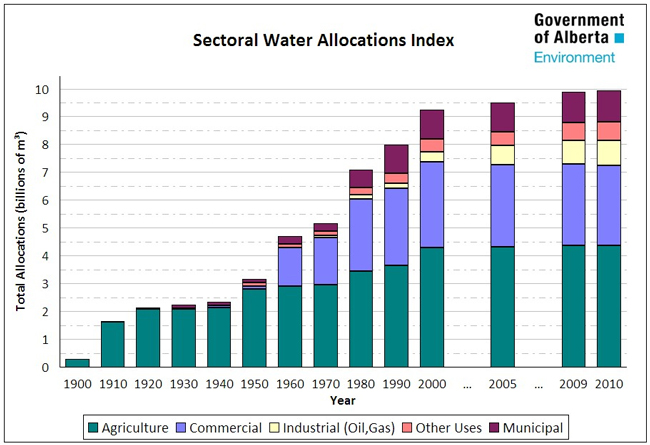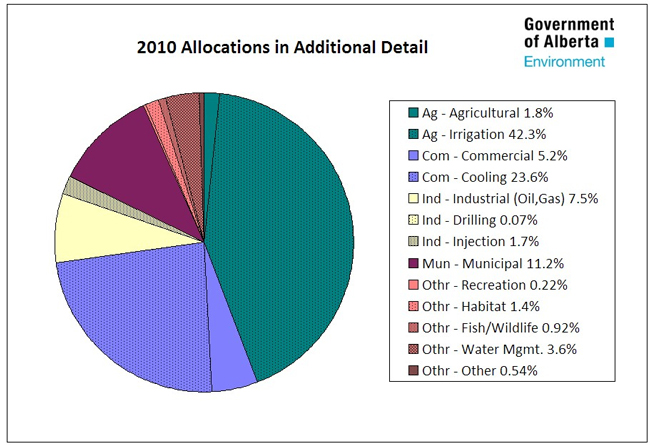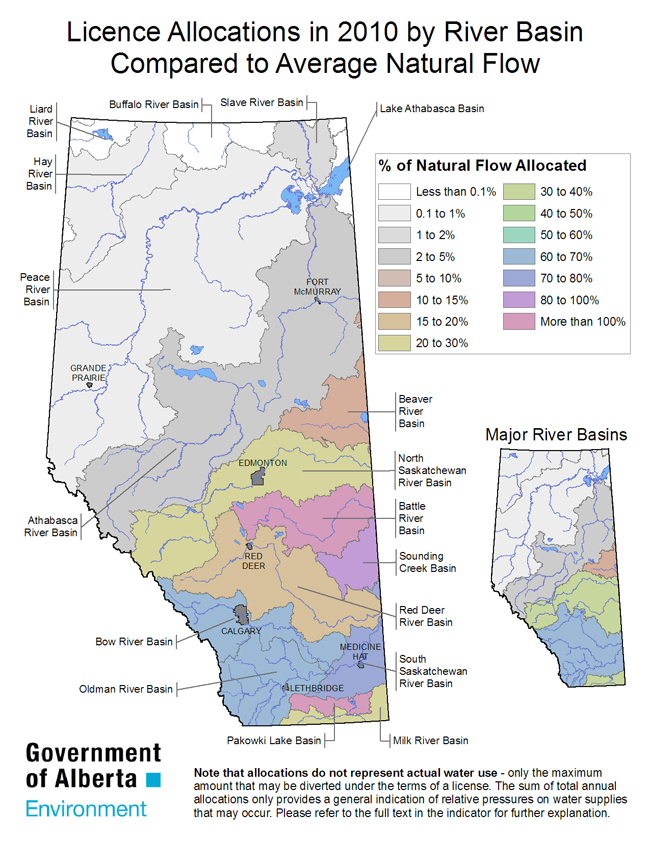Water Licences, Transfers, and Allocation
In order to use or divert ground or surface water in Alberta, the province requires you to obtain a licence, under the Alberta Water Act [i]. The following section looks at how Alberta’s water is governed, providing information on water licences, transfers, and allocation.
What is a Water Licence?
A water licence is required for any individuals wanting to use or divert water in Alberta. From business to individual use, the regulations apply if one wishes to use ground or surface water. Since August 2006, portions of the South Saskatchewan River Basin have been closed [ii] to new water licence applications, except for First Nations, Water Conservation Objectives (WCO) [iii], and water storage projects (as per an Approved Water Management Plan). This moratorium on the issuing of new water licences has created Canada’s first market-based system to transfer (trade) water licences.
Alberta’s existing water transfer system currently allows for the re-distribution (trading) of water licences between different water users, under certain conditions. The current system has several public policy protections: a public review of every water transfer, the consideration of hydrological and third-party impacts for each transfer, and the opportunity for the province to hold back 10 per cent of the allocation for environmental in-stream purposes [iv].
There are some cases where a licence is not required, such as with statutory household use, traditional agriculture use (for original landowners, see Section 19 of the Water Act), firefighting, wells equipped with hand pumps, and alternate watering systems, which use surface water for grazing livestock and/or certain types of dugouts.
It is important to note that there are also a number of basins in southern Alberta that are closed to new water licences. Within these basins, tools available for the sharing of water are laid out in the Water Act.
Transfer of a Water Allocation
Alberta’s Water Act allows the transfer of the right to divert a volume of water from a source of water supply [v], under a certain priority. There is no physical transfer of water from the land. This type of transfer is voluntary, with a willing seller and willing buyer.
The Alberta government monitors this system through a number of control mechanisms. A transfer can only be considered where water is allocated under a licence and where an approved water management plan is in place that allows transfers, or through an order of the Lieutenant Governor in Council, which authorizes the ability to transfer. A transfer can be reviewed by the Alberta government, which can withhold a percentage of the transferred water. In response to comments from Albertans on the potential long-term impact on the basic requirements for water, the Water Act specifically states that the rights related to household purposes and registrations for traditional agricultural uses are not subject to the transfer provisions. These rights will always remain attached to the land.
Transfers can be permanent or temporary. With a temporary transfer, the transferred allocation reverts to the original licence after a specified time period. The government’s holdback of up to 10 per cent of the water in an allocation transfer can remain in the natural water body or be held in a Water Conservation Objective licence and will not be available for reallocation for other uses. This holdback applies to permanent and temporary transfers of allocations.
Click here for more information on the Administrative Guidelines for Transferring a Water Allocation.
Note: the following information is based on material obtained from Government of Alberta sources available in 2013. As of May 2023, we are no longer able to find the original or updated material, but believe the information below may be of interest to you and worth retaining. Should you happen to find updated source material, please let us know. Should you be interested in seeing what source material we could find in 2023, see “Facts about water in Alberta” (2010) [vi].
Water Allocations in Alberta (2010, by sector)
This indicator shows the change in total water allocations over time. The allocation totals are broken down into the major sectors representing the types of usage for water in Alberta. Water allocations in Alberta have grown by seven per cent since 2000, surpassing 9.9 billion cubic metres by 2010. The rate of growth since 2000 has decreased slightly compared to the rate over the past 30 years.
Trend: Mixed; generally increasing provincially and across most sectors, but highly dependent upon individual river basin trends.


For the breakdown of sectoral water allocations in each of Alberta’s major river basins, click on the basin of interest:
Milk – South Saskatchewan – North Saskatchewan – Beaver – Athabasca – Peace/Slave – Hay
Licence Allocations in 2010 by River Basin (compared to Average Natural Flow)
Water allocations reflect the pressure on our rivers, lakes, and aquifers to provide water for various human uses. By comparing this use to the natural flows available, managers can identify where water shortages may develop and where water conservation and improved efficiency should be pursued. Allocations are a measure of the maximum amount of water that has been granted for use. However, many licensed water users do not require their full allocation, and many return water back to the environment after it has been used. Managers must consider many factors in managing and conserving water. It is important to consider not only how much of the allocated water is actually being used, but also how it is being used.
This indicator shows the proportion of water allocated for various uses in each of Alberta’s main sub-basins. Colour shading indicates how much water is allocated as a percentage of the natural flow in the river. The smaller map gives a broader overview of water allocation in Alberta’s major river basins. Trend: Allocations increasing in most basins.
Click here to view the historical trend (maps of water allocations in 1900, 1930,1960, 1990, and 2008).

Source: Alberta Environment
At first glance, the Battle River basin appears to be over-allocated (more than 100 per cent); however, the basin contains a large license that returns most of the water that is initially diverted, allowing for nearly all of the water to be reused or passed downstream. This is more clearly illustrated in the second map, which shows the consumptive portion of allocations that are contained in licences. Like the Battle, the amount of water consumed in other basins can be significantly less than the total allocation – indicating a substantial return flow component expected after the water is used.
Water allocation data is based on the water licences issued under the provincial Water Act. Flow data is collected by Alberta’s hydrometric monitoring network, which consists of over 340 stations located throughout the province. Where the recorded flows are regulated or have large human consumption, the natural flows are reconstructed using sophisticated computations and flow models, or “flow naturalization techniques”.
Please note that this measure does not apply to two small sub-basins in southeast Alberta. Pakowki Lake and Sounding Creek are “internal” drainage basins. As such, they only collect water and do not have an outflowing stream that can be measured in the same way as the other basins.
How are Water Licenses Transferred?
A “temporary transfer” and a “permanent transfer” are two types of water allocation transfers. A temporary transfer refers to a licence transferring back to the original licence-holder from the transferee automatically upon a chosen date. The date when the allocation reverts to the original licence holder is recorded on the licence and no further action is required. A permanent transfer is when a new licence transfer remains in place. If needed, the licence can be transferred back through the application process.
A transfer can also occur where an approved water management plan or an Order of Cabinet provides for it. It is important to note that licences can only be transferred if the licence is considered to be “in good standing.” This means the project described in the licence must explain all conditions and there must be no outstanding compliance issues. The government may apply up to a 10 per cent holdback of the water in an allocation transfer for a water conservation objective (WCO.)
Disclaimer of Accuracy of Data – Although the data found on the Alberta WaterPortal has been produced and processed from sources believed to be reliable, no warranty, expressed or implied, can be made regarding accuracy, adequacy, completeness, legality, reliability, or usefulness of any information.
Sources:
[i] Government of Alberta, n.d., Water Act. https://open.alberta.ca/publications/w03. Accessed 2023-05-10.
[ii] Government of Alberta, 2007, Bow, Oldman and South Saskatchewan River Basin Water Allocation Order. https://kings-printer.alberta.ca/1266.cfm?page=2007_171.cfm&leg_type=Regs&isbncln=9780779725748&display=html. Accessed 2023-05-10.
[iii] Government of Alberta, n.d., Water conservation objectives. https://www.alberta.ca/water-conservation-objectives.aspx. Accessed 2023-05-10.
[iv] Government of Alberta, n.d., About environmental flows. https://www.alberta.ca/about-environmental-flows.aspx. Accessed 2023-05-10.
[v] Government of Alberta, n.d., Water Allocation Transfer Under a Licence. https://www.alberta.ca/water-allocations-and-transfers.aspx#jumplinks-4. Accessed 2023-05-10.
[vi] Government of Alberta, 2010, Facts about water in Alberta. https://open.alberta.ca/dataset/1832cd36-bbeb-4997-ae81-67d3eedfcfe5/resource/18a9d64b-bad8-413a-8c63-77a548ec9d88/download/4888138-2010-facts-about-water-in-alberta-2010-12.pdf. Accessed 2023-05-11.
